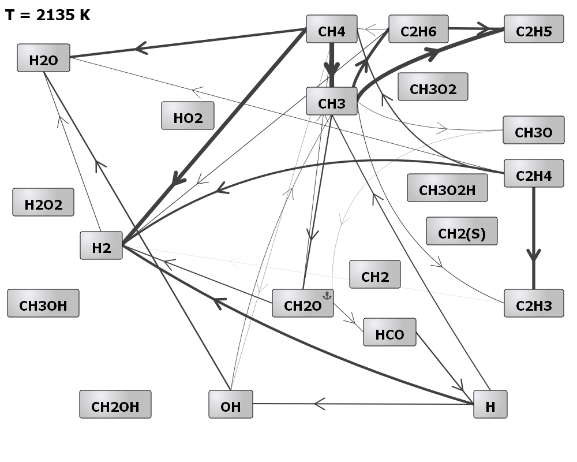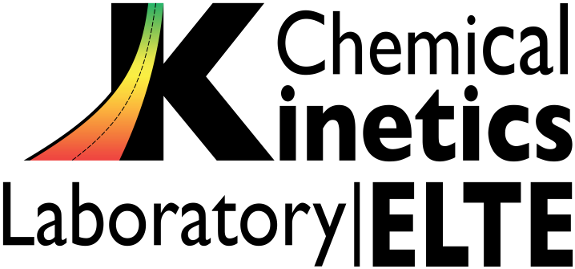FluxViewer++

FluxViewer++ is a reaction pathway visualization code. The program draws the species as boxes and the element fluxes as interconnecting arrows. Initially, a crude ("dumb computer logic") arrangement appears, which can be improved by moving the boxes using the drag'n'drop method. Important connections can be emphasized by editing out the less significant ones using a display threshold. The optimized, nice and chemically meaningful final figure can be saved as a picture and printed. Development and change of the connections with reaction progress can be inspected as an animation.
available at http://respecth.hu/
SEM: mechanism reduction with simulation error minimization
The simulation error minimization method identifies the redundant species and redundant reactions in a large detailed reaction mechanism by monitoring the error induced by the elimination of species and reactions during the reduction process.
The theory is detailed in the following article:
T. Nagy, T. Turányi
Reduction of very large reaction mechanisms using methods based on simulation error minimization
Combustion and Flame, 156 (2009) 417-428
Reduction of very large reaction mechanisms using methods based on simulation error minimization
Combustion and Flame, 156 (2009) 417-428
available at http://respecth.hu/
Minimal Spline Fit
Program Minimal Spline Fit determines a minimal-parameter spline curve that captures the noise-free evolution of a noisy data set and it estimates the standard deviation of the noise based on the fitted curve. The program fits Akima splines with increasing number (n) of control points and fits polynomials with increasing order (𝑛=0,1,2,…). The advantage of fitting splines over polynomials that it assumes nothing on the functional form of the data, thus it can be applied also in cases where it is not known or it is not an analytic function (e.g. obtained from solving a differential equation). Akima splines are cubic splines (piecewise, continuously-differentiable cubic polynomials) that are especially cheap to evaluate and do not lead to unnatural wiggles in the resulting curve opposed to B-splines and higher-order polynomials, etc. The optimal fitted curve can be deduced from the evolution of the fitting error as a function of parameters in the fitting curve.
The theory is detailed in the following article:
Tibor Nagy, Tamás Turányi
Minimal Spline Fit: a model-free method for determining statistical noise of experimental data series
Proceedings of the European Combustion Meeting – 2021, Paper 336, 14-15 April, 2021, Naples, Italy
Minimal Spline Fit: a model-free method for determining statistical noise of experimental data series
Proceedings of the European Combustion Meeting – 2021, Paper 336, 14-15 April, 2021, Naples, Italy
available at http://respecth.hu/
outgen is a Fortran code developed for flexible output generation during the investigation of combustion mechanisms. It is available for Windows, Mac OS X and Linux.
The current version supports fuels consisting of C, H and O, either as pure fuels or in mixtures of up to three fuel species. Three additional diluent species and oxygen may be defined. It can handle laminar burning velocity data, ignition delay time data, concentration profile data ("conc") and other data, including direct rate determinations ("direct"). Although multiple types of data can be handled together, it is often beneficial to define separate input files for the different types of measurements.
The current version supports fuels consisting of C, H and O, either as pure fuels or in mixtures of up to three fuel species. Three additional diluent species and oxygen may be defined. It can handle laminar burning velocity data, ignition delay time data, concentration profile data ("conc") and other data, including direct rate determinations ("direct"). Although multiple types of data can be handled together, it is often beneficial to define separate input files for the different types of measurements.
available at http://respecth.hu/
KINALC is a postprocessor to CHEMKIN based simulation programs. It has been interfaced to all programs of the CHEMKIN-II package (SENKIN, PREMIX, OPPDIF, PSR, SHOCK, and EQLIB), and most programs of the CHEMKIN-III package (SENKIN, PREMIX, OPPDIF, SHOCK, and EQUIL), and CHEMKIN4 package (Closed Homogeneous, Equilibrium, Flame speed calculator, Incident Shock, Opposed flow flame, Perfectly Stirred Reactor, Pre-mixed burner, Reflected Shock models), and also to the RUN1DL package. KINALC carries out three types of analysis: processing sensitivity analysis results, extracting information from reaction rates and stoichiometry, and providing kinetic information about the species. KINALC has a modular structure and can be easily extended by incorporating other methods for the analysis of reaction mechanisms and can be interfaced easily to other simulation programs.
available at http://respecth.hu/
MECHMOD is a code for the manipulation of CHEMKIN format mechanisms. During the development of combustion mechanisms you have to do several dull, mechanical things like converting the rate parameters from one unit to another, calculating the reverse rate parameters knowing the forward parameters and the thermodynamic data, or simply systematically eliminating some species from the mechanisms. To automate these tasks a utility program, called MECHMOD has been written. MECHMOD requires the usage of the CHEMKIN-II package. Using the CHEMKIN-II terminology, MECHMOD does the opposite to CKINTERP. CKINTERP creates a binary link (called chem.bin) file from a standard CHEMKIN mechanism text file, while MECHMOD restores the mechanism text file from the binary link file.Not only the original mechanism text file can be restored, but the mechanism can be modified in the following ways:
* all reversible reactions are transformed to pairs of irreversible reactions
* selected species are eliminated from the mechanism
* the pre-exponential factors and the activation energies are converted to different units
* the thermodynamic data are printed at the beginning of the mechanism.
* the room-temperature heat of formation and entropy data are modified in the NASA polynomials.
* all reversible reactions are transformed to pairs of irreversible reactions
* selected species are eliminated from the mechanism
* the pre-exponential factors and the activation energies are converted to different units
* the thermodynamic data are printed at the beginning of the mechanism.
* the room-temperature heat of formation and entropy data are modified in the NASA polynomials.
available at http://respecth.hu/

